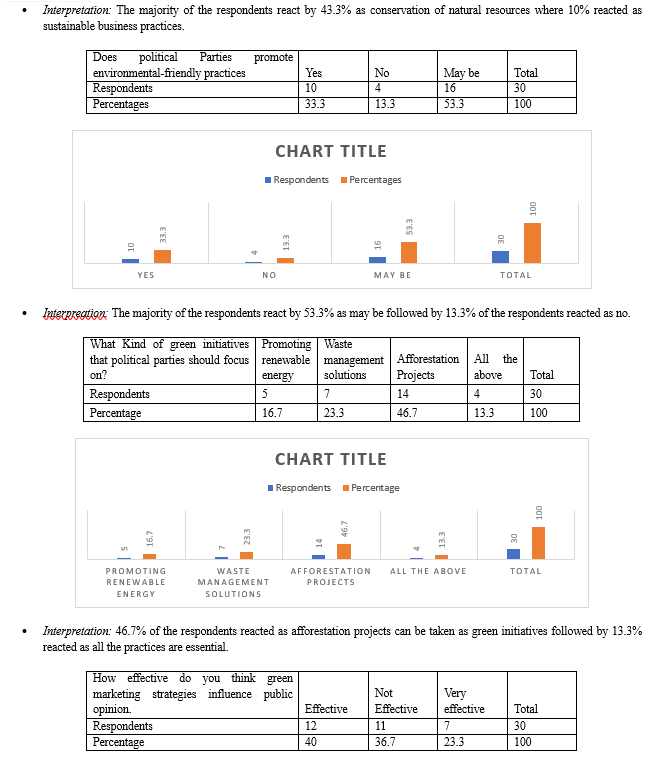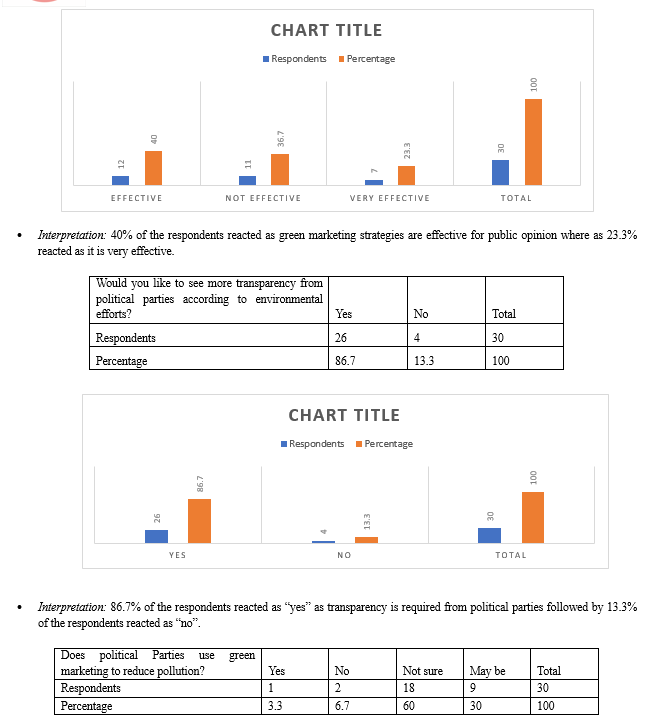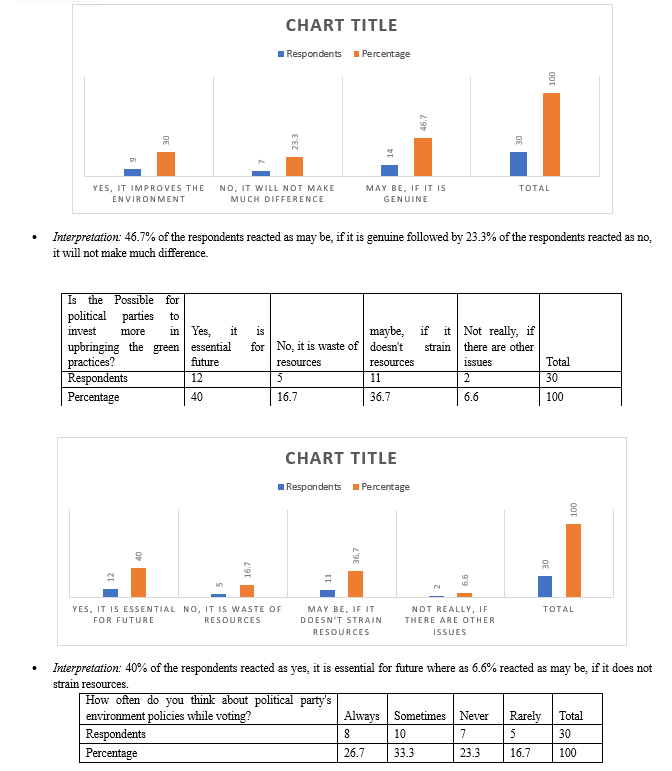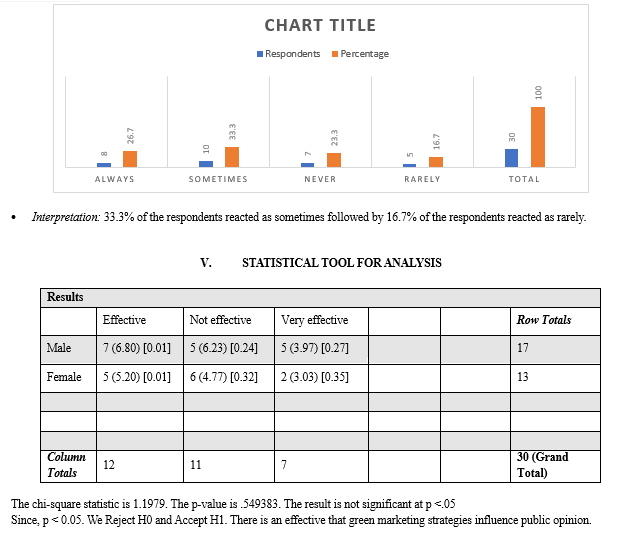Ijraset Journal For Research in Applied Science and Engineering Technology
- Home / Ijraset
- On This Page
- Abstract
- Introduction
- Conclusion
- References
- Copyright
A Study on Green Marketing Strategy Adoption by Indian Political Party Brands with Special Emphasis on Marketing
Authors: M. Akhila Reddy, Dk. Manoj Reddy
DOI Link: https://doi.org/10.22214/ijraset.2024.63454
Certificate: View Certificate
Abstract
This study explores the adoption of green marketing strategies by political parties in India, with a focus on their marketing practices and environmental sustainability initiatives. In recent years, there has been a noticeable shift towards sustainability in various sectors, including politics, driven by increasing environmental awareness and regulatory pressures. Methodologically, the study employs qualitative research methods including case studies and content analysis of party manifestos, speeches, and promotional materials. By examining these sources, the study seeks to identify trends, challenges, and successes in the adoption and implementation of green marketing strategies by political parties. The findings are expected to provide insights into the effectiveness of green marketing in enhancing political brand image, engaging voters concerned with environmental issues, and influencing policy discourse. Moreover, the study aims to contribute to the literature on green marketing in emerging economies like India, where sustainability practices are increasingly becoming a focal point for organizations across sectors. This research is significant as it explores the intersection of marketing, sustainability, and political communication, highlighting the role of political parties in promoting environmental responsibility and shaping public perception through strategic green initiatives.
Introduction
I. INTRODUCTION
In a recent development, the increase in knowledge of environmental problems is transforming the way people live. There has been a shift in consumer mindset to adopt a green lifestyle. Individuals are making efforts to minimize their influence on nature. Although few, corporations perceive these variations in clients’ behaviour as an opportunity to outdo each other and establish themselves within the industry. The challenge now is to keep our natural environment safe and secure while trying to satisfy consumer needs. The emergence of green marketing as a significant phenomenon in both developing and developed economies, including India, underscores its pivotal role in fostering sustainable development. This research paper highlights the concept, necessity, and significance of green marketing. It emphasizes the imperative of aligning business strategies with environmental concerns, reflecting a growing awareness of environmental sustainability among consumers and businesses alike. By prioritizing eco-friendly practices and products, green marketing serves as a vital strategy for fostering long-term sustainability and mitigating environmental impacts.
Green marketing, as defined by the American Marketing Association, revolves around promoting products deemed environmentally safe. This encompasses a wide array of actions, from altering products themselves to adjusting production processes, packaging, and advertising strategies. It embodies a holistic marketing approach where every stage, from production to consumption to disposal, aims for reduced environmental impact. With increasing awareness of issues like global warming, non-biodegradable waste, and pollutant harm, both consumers and marketers are increasingly prioritizing eco-friendly alternatives. While some may narrow green marketing to product promotion with environmental attributes, it extends far beyond that
Green marketing strategies offer Indian political parties a compelling pathway to connect with environmentally conscious voters. By weaving green policies into their manifestos, parties can resonate with citizens increasingly alarmed by environmental crises like pollution, deforestation, and climate change. Advocating for sustainable development underscores parties' dedication to confronting these urgent challenges. Moreover, infusing green messaging throughout their campaigns enables parties to carve out distinct identities in a crowded political landscape. Prioritizing renewable energy, conservation, waste management, and pollution control resonates deeply, particularly with younger demographics valuing environmental sustainability.
Digital platforms and social media become powerful allies in amplifying these messages. Parties can leverage these channels to disseminate environmental policies, engage voters, and show case their sustainability efforts effectively. Collaborating with environmental groups, NGOs, and experts not only adds credibility but also enriches parties' understanding of green issues. Collaborations provide invaluable resources and insights, bolstering the implementation of impactful green marketing strategies. Public events and community outreach further solidify parties' commitment to the environment. Active involvement in conservation activities showcases leadership and fosters positive perceptions among voters. Integrating green marketing isn't just about winning votes; it's about demonstrating a genuine dedication to addressing environmental challenges and steering India toward sustainable development.
Green products can be distinguished by several key attributes:
- Originating from natural sources or sustainably grown materials.
- Demonstrating recyclability, reusability, and biodegradability to minimize environmental impact.
- Incorporating natural ingredients, free from synthetic or harmful chemicals.
- Utilizing recycled materials and non-toxic compounds in production processes.
- Complying with regulations on chemical usage and ensuring safety for both consumers and ecosystems.
- Leaving minimal to no negative impact on the environment during their lifecycle.
- Adhering to ethical standards by refraining from animal testing.
- Featuring eco-conscious packaging solutions such as reusable or refillable containers to reduce waste and promote sustainability.
Organizations that prioritize green marketing and embrace eco-friendly practices often win the favor of customers. Regardless of their size, any organization can transition into a green marketer by employing a variety of strategies. Firstly, the design of green products and services, such as solar water heaters, holds immense potential to slash energy consumption and mitigate environmental impact. This proactive approach not only appeals to environmentally conscious consumers but also aligns with global sustainability goals. Secondly, positioning a brand as environmentally friendly can yield substantial benefits in terms of market appeal and brand loyalty. Achieving this requires obtaining relevant certifications and establishing partnerships with recognized green organizations. Companies can enhance their reputation as responsible stewards of the environment, thereby attracting a loyal customer base committed to sustainability. Thirdly, highlighting the cost-effectiveness of green offerings can serve as a powerful incentive for consumers. For instance, the promotion of CNG cars emphasizes not only their economic advantages but also their positive environmental impact. This dual benefit resonates strongly with consumers seeking both financial savings and eco-friendly alternatives. Adopting green distribution and logistics practices is essential for minimizing environmental harm throughout the supply chain
Implementing green disposal methods for hazardous waste underscores a company's commitment to ecological well-being. By responsibly managing waste streams, prioritizing recycling, and reclamation efforts, organizations can mitigate pollution and preserve natural resources. Embracing green marketing and eco-friendly practices is not just a business strategy; it's a moral imperative in today's world. By integrating sustainability into every aspect of their operations, organizations can not only attract customers but also contribute positively to the planet's health and longevity.
II. REVIEW OF LITERATURE
- Polanski et al., (1998) Protiero (1996)
As environmental challenges intensify, there's a growing emphasis on environmental protection. With heightened awareness among modern consumers, businesses are increasingly shifting towards green practices.
2. Oyewole, P. (2001)
This paper explores the interconnection between green marketing, environmental justice, and industrial ecology, advocating for heightened consideration of environmental justice within green marketing practices. It underscores the need for a more comprehensive understanding of environmental justice's role in shaping green marketing strategies. Additionally, it proposes a research agenda aimed at assessing consumer awareness of environmental justice principles and their willingness to shoulder associated costs.
3. Donaldson's (2005)
The study conducted in Great Britain observed a positive shift in consumers' ecological attitudes overall. However, the study also revealed a notable tendency among consumers to place greater trust in well-established commercial brands, while displaying conviction towards vague or weak "green" claims. This conviction often led to consumers failing to fully integrate environmental concerns into their purchasing behaviour.
4Sanjay K. Jain & Gurmeet Kaur (2004)
The observation is the increasing responsiveness of business firms to environmental challenges through the adoption of green marketing strategies. They noted the pivotal role of green consumerism in driving corporate environmentalism and fostering a shift toward green marketing orientation among businesses. Drawing on data gathered from a field survey, the paper evaluated the level of environmental awareness, attitudes, and behaviours among consumers in India.
5. Kilbourne W.E. (1998)
The study explored the stagnation of green marketing within the confines of the prevailing paradigm. The author highlighted the necessity of examining various dimensions within the marketing/environment relationship to overcome these limitations. Specifically, Kilbourne identified the economic, political, and technological aspects of the cultural frame of reference as critical areas requiring scrutiny. By delving into these dimensions, researchers and practitioners can gain a deeper understanding of the complex interplay between marketing strategies and environmental concerns.
6. Medleson and Polanski (1995)
Both media outlets and environmental organizations are investing significant efforts in raising awareness about environmental safety. Their initiatives span from influencing policy-making processes to monitoring and reporting on the actual progress made in environmental protection. Through various forms of communication, including news reports, documentaries, and advocacy campaigns, the media plays a crucial role in sensitizing the public to environmental issues. Similarly, environmental organizations actively engage in educational programs, grassroots activism, and lobbying efforts to promote environmental conservation and sustainability.
7. Beatty (2001)
They delineated three key phases of the term "green marketing." Firstly, it involves addressing environmental issues and devising solutions to mitigate them. Secondly, there is a focus on eliminating pollution, which significantly contributes to environmental harm. This entails implementing clean manufacturing processes and utilizing recycled packaging, while also leveraging technology to aid in pollution reduction efforts. Lastly, the third phase centers on sustainable development, emphasizing the adoption of green practices that can be maintained over the long term.
III. RESEARCH METHODOLOGY
A. Research Gap
Comprehensive analyses on the adoption of green marketing strategies by Indian political parties with a marketing focus underscores a critical research gap. While green marketing has gained considerable traction in the global corporate sector, its application and effectiveness within the realm of Indian politics remain largely unexplored. At the core of this gap, is the absence of research examining the extent to which Indian political parties incorporate green marketing principles into their campaigns and policies? Factors such as party ideology, voter demographics, and electoral competition are likely to play pivotal roles in shaping the discourse on environmental messaging and policy formulation.
B. Need Of The Study
Understanding the impact of green marketing strategies on voter behaviour and electoral outcomes is crucial for assessing the effectiveness of environmentally focused political campaigns. By investigating whether parties emphasizing environmental sustainability garner increased support or gain a competitive edge over their rivals, this research sheds light on the electoral implications of green messaging and policy platforms. Such insights are essential for identifying successful strategies and areas for improvement, thereby informing more targeted and impactful environmental advocacy efforts within the political sphere.
C. Purpose Of The Study
The study seeks to evaluate the electoral implications of green marketing strategies by examining whether parties prioritizing environmental issues garner increased support or achieve a competitive edge over their counterparts. This investigation aims to bridge a notable gap in the literature by offering a thorough comprehension of how Indian political parties incorporate environmental concerns into their marketing approaches. This entails analysing the adoption of green marketing principles, the promotion of sustainability initiatives, and the integration of eco-friendly practices into party operations.
D. Problem Statement
There exists a significant gap in understanding the incorporation of green marketing strategies within the marketing endeavours of Indian political parties. Despite the global emphasis on sustainability across various sectors, particularly in corporate marketing, empirical research addressing the adoption and efficacy of green marketing within the Indian political landscape is notably lacking. This project aims to delve into the extent to which Indian political parties integrate environmental considerations into their marketing strategies, encompassing the adoption of green marketing principles, promotion of sustainability initiatives, and integration of eco-friendly practices into party operations. By addressing this gap in the existing literature, the project endeavours to uncover the underlying motivations guiding parties' decisions regarding the adoption of green marketing strategies, evaluate the impact of such strategies.
E. Objectives Of The Study
- To understand the concept of green marketing.
- To explore the significance and necessity of green marketing and its challenges.
F. Research Design
The research design is a systematic to guide a research project. It involves employing scientific methods to investigate a phenomenon and gain new knowledge by relating it to existing information. It resolves around the existence of green marketing strategies adoption by political party which impact on marketing.
G. Research Type
Descriptive in nature.
- Sampling Technique: Random sampling technique was utilised for the purpose of the study.
- Random Sampling: Random sampling is a technique where participants are selected from a population in a purely random manner, ensuring that each member has an equal chance of being included.
H. Data Collection Methods
Primary data are those that have been personally collected or have been obtained via direct observation. It refers to information that is original in character and gathered for a specific purpose from the area of inquiry. Primary data for the study were mostly gathered utilizing the survey technique and the tool questionnaire.
Secondary data refers to information that has already been gathered and subjected to statistical analysis by another party. Here is where the secondary data came from. Different dictionaries, registries, publications, and journals. Publications, etc. websites for the company.
POPULATION: 100
SAMPLE SIZE: 30
SAMPLE UNIT: Hyderabad
I. Questionnaire
A well-structured questionnaire with straightforward questions is employed for data gathering. Closed-ended, Likert-scale, and multiple-choice items are all included in the survey.
J. Tools Used
Chi square, bar graphs, Percentages.
K. Hypothesis
H0: There is no effective impact that green marketing strategies influence public opinion
H1: There is an effective impact that green marketing strategies influence public opinion.







VI. FINDINGS
- The total respondents are 30 out of which 56.7% are male and 43.3% are female.
- The majority of respondents are between 20-30 followed by below 20 years.
- Most of the Respondents are from PG followed by degree respondents.
- 43.3% of the respondents are profession and 16.7% of the respondents are freshers.
- The majority of the respondents react by 43.3% as conservation of natural resources where 10% reacted as sustainable business practices.
- The majority of the respondents react by 53.3% as may be followed by 13.3% of the respondents reacted as no.
- 46.7% of the respondents reacted as afforestation projects can be taken as green initiatives followed by 13.3% reacted as all the practices are essential.
- 40% of the respondents reacted as green marketing strategies are effective for public opinion where as 23.3% reacted as it is very effective.
- 86.7% of the respondents reacted as “yes” as transparency is required from political parties followed by 13.3% of the respondents reacted as “no”.
- 60% of the respondents said that they are not sure as it reduces the pollution followed by 3.3% of the respondents reacted as yes.
- 53.3% of the respondents reacted as yes, multiple times followed by 6.7% of the respondents reacted as I’m not sure.
- 46.7% of the respondents reacted as may be, if it is genuine followed by 23.3% of the respondents reacted as no, it will not make much difference.
- 40% of the respondents reacted as yes, it is essential for future where as 6.6% reacted as may be, if it doesn’t strain resources.
- 33.3% of the respondents reacted as sometimes followed by 16.7% of the respondents reacted as rarely.
VII. SUGGESTIONS
Government intervention also plays a crucial role in the effective implementation of green marketing. Specific and stringent laws need to be created and enforced to regulate environmental standards and practices. Without government support and enforcement, the concept of green marketing cannot be fully realized. When consumers, organizations, and governments work together towards the common goal of minimizing environmental impact, significant progress can be made towards creating a more sustainable world. However, it is not enough for companies to simply green their products; consumers also expect them to be affordable and help reduce environmental impact in their own lives. Green marketing remains a relatively low priority for many businesses, but it has the potential to be a powerful Unique Selling Proposition when effectively targeted at the right audience. to enhance consumer awareness about the merits of green products.
This entails educating consumers about environmental threats and ensuring they are aware of the issues that green products aim to address. Green marketing campaigns and advertising play a crucial role in achieving this goal, as they help raise awareness and educate consumers about the benefits of environmentally friendly products. By motivating consumers to switch brands or even pay a premium for greener alternatives, organizations can drive demand for sustainable products and encourage sustainable consumption patterns. Clear and transparent communication about the environmental benefits of products is essential to build consumer trust and credibility in green marketing initiatives. By raising consumer awareness, empowering consumers, addressing false claims, and collaborating with governments, businesses can harness the potential of green marketing to drive positive environmental change and meet consumer demand for sustainable products. Encouraging consumers to recognize their role in effecting positive environmental change is another crucial aspect of successful green marketing. When consumers perceive their choices as impactful and capable of fostering environmental improvements, they are more inclined to opt for green products.
Conclusion
In the Indian market, customers are increasingly willing to pay a premium for green products. However, it\'s becoming increasingly evident that current consumption levels are unsustainable, necessitating a shift in consumer behaviour and attitudes towards more environmentally friendly lifestyles. Green marketing plays a crucial role in promoting this shift, as it requires consumers to desire a cleaner environment and be willing to invest in it, whether through purchasing higher-priced goods, adopting modified lifestyles, or supporting governmental intervention. For firms to effectively lead the green marketing revolution, it is imperative that consumer demand for environmentally friendly products and lifestyles continues to grow. Moreover, an environmentally committed organization not only produces goods with reduced environmental impact but also has the potential to influence its suppliers to adopt more sustainable practices. Additionally, both final consumers and industrial buyers possess the ability to exert pressure on organizations to prioritize environmental considerations in their corporate culture. By doing so, they can ensure that all organizations minimize their detrimental environmental impact, contributing to a more sustainable future. The implementation of strict regulations globally would cause drastic changes in the business landscape, as green marketing emerges as a vital tool in combatting pollution and safeguarding the environment. From a business perspective, effective marketing extends beyond mere persuasion; it involves actively engaging consumers in promoting products. Therefore, green marketing must not be viewed as just another marketing approach but embraced with heightened enthusiasm due to its environmental and social significance. As the illusion of global warming looms ominously, it becomes imperative for green marketing to transition from being an occasional practice or passing trend to a standard operating procedure. Integral to this shift is the widespread adoption of systematic and universal recycling practices for paper, metals, plastics, and other materials, ensuring they are processed in a safe and environmentally benign manner. By making green marketing the norm rather than an exception, businesses can play a pivotal role in mitigating environmental degradation and fostering a sustainable future for generations to come. The challenge now is to keep our natural environment safe and secure while trying to satisfy consumer needs. The emergence of green marketing as a significant phenomenon in both developing and developed economies, including India, underscores its pivotal role in fostering sustainable development. This research paper highlights the concept, necessity, and significance of green marketing. It emphasizes the imperative of aligning business strategies with environmental concerns, reflecting a growing awareness of environmental sustainability among consumers and businesses alike.
References
[1] Shafaat F. “Green Marketing, excel international journal of multidisciplinary management studies” 2012. [2] Dr. Sarawade W.K. “Conceptual development of green marketing in India” vol 1, June 2012.1-6. [3] https://www.researchgate.net/publication/377434822_GREEN_MARKETING_A_CONCEPTUAL_STUDY_AND_CURRENT_SCENARIO_CHALLENGE [4] Rahul Singal Et al, “Green Marketing: Challenges and Opportunity, International Journal of Innovation” vol II, Feb 2013, 470-474. [5] file:///C:/Users/dhanu/Downloads/ijrcm-4-IJRCM-4_vol-7_2017_issue-01.pdf [6] Mathur, L.K & Muthur, I, “An analysis of the wealth effects of green marketing strategies,” Journal Business Research, 2000.193-200. [7] R Srikanth Et al, “Contemporary green marketing-brief reference to Indian scenario, International Journal of Social Science and interdisciplinary research” vol I, Jan 12,26-38. [8] Parul Yadav, Bhawna Agarwal, Jones Mathew “Green Marketing Strategy Adoption by Indian Political Party Brands with Special Emphasis on Marketing Mix” vol 53, May 2023. [9] https://indianjournalofmarketing.com/index.php/ijom/article/view/172727 QUESTIONNAIRE Gender Male Female Age < 20 years Between 20 -30 > 30 years Qualification UG PG Other Occupation Fresher Professional Employee Why do you mean by green marketing Promoting Eco-friendly products Environmental awareness campaign Conservation of natural resources Sustainable business practices Does political parties promote environmentally friendly practices Yes No Maybe What kind of green initiatives that political parties should focus on? Promoting renewable energy waste management solutions Afforestation projects all the above How effective do you think green marketing strategies influence public opinion. Effective Not effective Very effective Would you like to see more transparency from political party according to environmental efforts? Yes No Does political parties use green marketing to reduce pollution? Yes No Not sure Maybe Did you ever participated in any green campaign, which is held by Indian political party? Once or twice Yes, multiple times No, never Im not sure Do you believe implementing the green marketing strategies will improve the image of political party? Yes No Maybe Is possible for political parties to invest more in upbringings the green practices? Yes No Maybe Not really How often do you think about political parties environment policies while voting? Always Sometimes never Rarely
Copyright
Copyright © 2024 M. Akhila Reddy, Dk. Manoj Reddy. This is an open access article distributed under the Creative Commons Attribution License, which permits unrestricted use, distribution, and reproduction in any medium, provided the original work is properly cited.

Download Paper
Paper Id : IJRASET63454
Publish Date : 2024-06-25
ISSN : 2321-9653
Publisher Name : IJRASET
DOI Link : Click Here
 Submit Paper Online
Submit Paper Online

